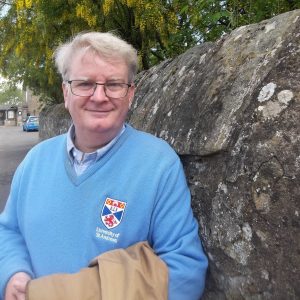A Journey Through Lent in Monastic Company

This semester, Dr. William Hyland, Lecturer in Church History at St. Mary’s College, will offer a series of blog posts on monastic spirituality. They originate from a series of lectures he delivered at All Saints Church in St. Andrews. We are grateful for the many ways in which Dr. Hyland contributes to our academic community, and we appreciate his expertise in this area. This first post serves as his introduction to the series.
This past Lent on five consecutive Thursdays I gave a series of talks at All Saints Church in St Andrews on how aspects of monastic spirituality could possibly be helpful for Christians who are living in the world. To do so I drew upon writers from the Benedictine tradition, but also many other writers, male and female, from the wider monastic tradition of East and West from the patristic era through the late twentieth century. In each talk, accompanied by visual imagery, I tried to illustrate the various points through quotations from various monastic spiritual teachers, and relevant imagery.
The first talk was entitled The Benedictine Way of Attentiveness. Here I pointed out many similarities between Benedictine and Anglican approaches to holiness. After an overview of monastic history before the sixth century Benedictine Rule, I focused on the balance in the latter between 3 aspects of prayerful attentiveness that made up each day in the monastery: liturgical prayer, manual labor, and spiritual reading. If all of these activities are approached in a prayerful way, they help cultivate an awareness of the presence and transforming power of God in each moment and in the everyday tasks of life. I also discussed how the vows of the Benedictine life, namely stability, obedience and lifelong conversion of life, can be very helpful when creatively applied in a lay context.
The second talk, entitled Lectio Divina: Praying with Scripture, was concerned with some of the ways and methods that characterize the use of Scripture for private prayer in the monastic tradition. One method discussed was that taught by John Cassian in the fifth century, which he in turn had learned from the Desert Fathers. As discussed in the ninth and tenth books of his Conferences, it involves the frequent repetition of a single verse from Scripture, Psalm 70:1, “O God come to my assistance, O Lord, make speed to help me.” By giving oneself over to what Cassian calls ‘the poverty of the verse”, we gradually allow the Holy Spirit to teach us how to pray, and to let prayer permeate our whole life in this way. I then went on to discuss the quintessential monastic prayer known as lectio divina, or sacred reading. This ancient practice was discussed in its definitive form by the twelfth-century Carthusian monk Guigo, where he describes the four stages of praying with a passage from Scripture as Reading, Meditation, Prayer and Contemplation.
The importance of Scriptural prayer for growth in the spiritual life was carried over into the next talk entitled Overcoming the False of Shadow Self. This talk examined how a twentieth century Cistercian monk, Thomas Merton, discussed the role of the Psalms and all Scripture in helping the Christian to develop authentic ways of self-examination, and also to allow the God who is Love to speak to us through the Scriptures and transform all of our relationships, with God and one another. After discussing Merton, I showed how what Merton expressed in a modern idiom for his twentieth-century audience had deep roots in the psychology and spiritual teachings of his great twelfth-century Cistercian forebears, particularly Bernard of Clairvaux, William of St Thierry, and Aelred of Rievaulx.
The fourth talk was entitled Sacrifice. First of all, it examined the various ways that liturgical prayer, particularly the Divine Office, has been described as a “sacrifice of praise.” I then discussed the ways that the monastic tradition, including St Augustine, has brought out the rich aspects of how our own lives can be joined to the Sacrifice of Christ. I then discussed, using modern writers such as Dom Columba Marmion, Catherine de Hueck Doherty as well as older writers such as Brother Lawrence and various monks from the Syriac tradition, how these ideas of liturgical “sacrifice” flow into and enrich our everyday lives and relationships with other people, and then in turn our everyday lives enrich our liturgical experience.
The final talk was on how throughout the history of the Church the monastic tradition gives us various approaches to meditating on the events of the Passion, and what they can mean for our own spiritual life. We also discussed through imagery how portrayals of the Passion through art have followed these different trajectories of the tradition, and illustrated this through many quotations from monastic writers and mystics, including men and women from the Franciscan tradition, and many others. This was accompanied by a practical discussion of the variety of ways to think about the Passion in prayer and reflection.
Each of the talks was preceded and concluded by appropriate prayers chosen by the Rector, which sometimes included singing a final hymn together. The discussion following each talk brought out certain aspects of the topics, including members of the group sharing their own experiences